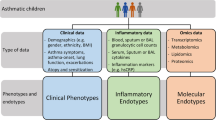Abstract
Purpose of Review
Asthma is a common inflammatory airway disease, which affects more than 300 million people worldwide. Although conventional drugs are effective for most of the patients with mild-to-moderate asthma, they are less effective for patients with difficult-to-treat or severe asthma. Identification of asthma endotypes and biomarkers will lead to more precise approaches to treat asthma.
Recent Findings
Asthma subphenotypes and endotypes have been described based on clinical variables and sputum granulocytes. A recent asthma endotype study has been summarized based on the combination of T2 (FeNO) and non-T2 (IL-6) biomarkers. Discovery of potential biomarkers for asthma has been discussed in the context of omics approaches. Current biologic drugs for asthma have been summarized, and the future direction of precise treatment of asthma has been suggested.
Summary
This review provides a concise overview of the current state of subphenotypes, endotypes, biomarkers, omics approaches, and biologic drugs in asthma.

Similar content being viewed by others
References
Papers of particular interest, published recently, have been highlighted as: • Of importance •• Of major importance
Global Initiative for Asthma. Global Strategy for Asthma Management and Prevention (GINA). [accessed July 1, 2019; updated 2019]. Available at https://ginasthma.org
• Moore WC, Meyers DA, Wenzel SE, et al. Identification of asthma phenotypes using cluster analysis in the Severe Asthma Research Program. Am J Respir Crit Care Med. 2010;181:315–23 This is a study showing heterogeneous clinical asthma subphenotypes.
Tliba O, Panettieri RA Jr. Paucigranulocytic asthma: uncoupling of airway obstruction from inflammation. J Allergy Clin Immunol. 2019;143:1287–94.
Hastie AT, Moore WC, Meyers DA, Vestal PL, Li H, Peters SP, et al. Analyses of asthma severity phenotypes and inflammatory proteins in subjects stratified by sputum granulocytes. J Allergy Clin Immunol. 2010;125:1028–36.
Moore WC, Hastie AT, Li X, Li H, Busse WW, Jarjour NN, et al. Sputum neutrophil counts are associated with more severe asthma phenotypes using cluster analysis. J Allergy Clin Immunol. 2014;133:1557–63.
•• Li X, Hastie AT, Peters MC, et al. Investigation of serum IL-6 and IL6R levels as biomarkers for asthma severity and asthma exacerbations. Am J Respir Crit Care Med. 2019;199:A2687 This is a study showing asthma endotypes based on T2 (FeNO or blood eosinophils) and non-T2 (IL-6) biomarkers.
Tiotiu A. Biomarkers in asthma: state of the art. Asthma Res Pract. 2018;4:10.
Li X, Ampleford EJ, Howard TD, Moore WC, Torgerson DG, Li H, et al. Genome-wide association studies of asthma indicate opposite immunopathogenesis direction from autoimmune diseases. J Allergy Clin Immunol. 2012;130:861–8.
Demenais F, Margaritte-Jeannin P, Barnes KC, et al. Multiancestry association study identifies new asthma risk loci that colocalize with immune-cell enhancer marks. Nat Genet. 2018;50:42–53.
Zhu Z, Lee PH, Chaffin MD, Chung W, Loh PR, Lu Q, et al. A genome-wide cross-trait analysis from UK Biobank highlights the shared genetic architecture of asthma and allergic diseases. Nat Genet. 2018;50:857–64.
Shrine N, Portelli MA, John C, Soler Artigas M, Bennett N, Hall R, et al. Moderate-to-severe asthma in individuals of European ancestry: a genome-wide association study. Lancet Respir Med. 2019;7:20–34.
Pividori M, Schoettler N, Nicolae DL, Ober C, Im HK. Shared and distinct genetic risk factors for childhood-onset and adult-onset asthma: genome-wide and transcriptome-wide studies. Lancet Respir Med. 2019;7:509–22.
Kan M, Shumyatcher M, Himes BE. Using omics approaches to understand pulmonary diseases. Respir Res. 2017;18:149.
Kersten ET, Koppelman GH. Pharmacogenetics of asthma: toward precision medicine. Curr Opin Pulm Med. 2017;23:12–20.
Agache I, Akdis CA. Precision medicine and phenotypes, endotypes, genotypes, regiotypes, and theratypes of allergic diseases. J Clin Invest. 2019;130:1493–503.
Author information
Authors and Affiliations
Corresponding author
Ethics declarations
Conflict of Interest
The author declares that he has no conflict of interest.
Human and Animal Rights and Informed Consent
This article does not contain any studies with human or animal subjects performed by the author.
Additional information
Publisher’s Note
Springer Nature remains neutral with regard to jurisdictional claims in published maps and institutional affiliations.
This article is part of the Topical Collection on Asthma
Rights and permissions
About this article
Cite this article
Li, X. Hot Topic: Precision Medicine for Asthma—Has the Time Come?. Curr Allergy Asthma Rep 19, 45 (2019). https://doi.org/10.1007/s11882-019-0881-3
Published:
DOI: https://doi.org/10.1007/s11882-019-0881-3




